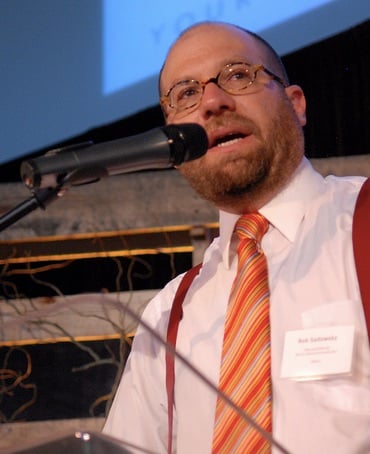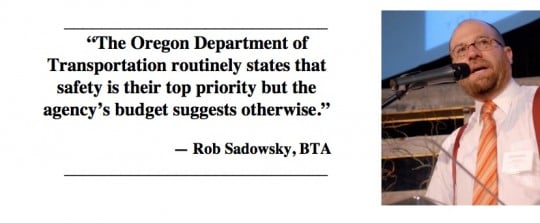Rob Sadowsky, the executive director of the Bicycle Transportation Alliance has issued a public statement about the serious injury collision that happened in southeast Portland on Sunday.
The statement lists five things Sadowsky feels need to happen in order to, “move from injuring, maiming, and killing people on the road to a place where traffic fatalities are few and far between.” The statement will be sent to BTA members later today.
I’ve shared it below in its entirety:
Imagine being a young athlete, 22 years old, on your way to visit your mother. In the blink of an eye, you get in a crash, nearly die, and lose your leg. That’s what happened to Alistair Corkett on Sunday and what sparked protests this week. Corkett’s life is changed forever, the driver who hit him will certainly carry this with him and Alistair’s mother will never think of Mothers Day in the same way.
On Monday, in response to this crash, nearly 100 people on SE 26th and Powell performed some “radical acts” as part of a protest: they rode bicycles on the street, stood next to it chatting, and walked across it confidently with their kids. These are activities that would be normal on a typical, healthy Portland street but Powell is not one of those. Despite the fact that a school and a park are along this street, we have become so used to it being dangerous that these perfectly legal activities, along with some signs, attracted police, two Oregon Department of Transportation (ODOT) staffers, and news helicopters.
That’s a sign that something is seriously wrong at this intersection. That’s a sign that we need to do something to allow people to walk, bike, and drive safely. It’s a sign that we must put our resources and efforts into fixing the city’s “high crash corridors” and dangerous intersections.
The fact is that this crash was entirely preventable. In fact, we believe that most crashes are preventable. Here’s what needs to be done to move from injuring, maiming, and killing people on the road to a place where traffic fatalities are few and far between:
CREATE PROTECTED BIKEWAYS AND SIGNALIZED CROSSINGS.
Sharing space works on slow, low-traffic streets like neighborhood greenways but Monday’s protest perfectly illustrated the need for separate, protected bikeways and signalized crossings on our big streets. It was remarkable to see how inefficient a busy street becomes when pedestrians cross at an unsignalized intersection and just a few bikes mix with a lot of cars in the same lane. Anyone frustrated by being stuck behind bicycles in their car should be quick to see the value of protected bikeways and signalized crossings.Advertisement
FIX HIGH CRASH CORRIDORS THAT CAUSE CONGESTION.
High Crash Corridors like Powell are streets that are disproportionately dangerous to their users. These streets essentially force people into cars. For many, the only way to cross them safely is in a car. The only way to move along them is in a car. Want to get to Cleveland High School? Get in the car. Little league practice at Powell City Park? Get in the car. The result? Lots of cars and a dangerous focus on moving those cars as quickly as possible to accommodate even more cars. If walking, biking, or taking transit were safer and more realistic options, there would be far fewer cars on the road competing for space.BUILD POWELL-DIVISION HIGH CAPACITY TRANSIT.
We have an opportunity to fix Powell. Metro and Trimet are in the early stages of planning a high capacity transit route along inner Powell. It will likely run as far east as 82nd before turning north to run along Division. This project will include millions of dollars of improvements for walking and biking along its path but the current question is: is it worth the effort and expense to make improvements along the route itself or will improving parallel routes suffice? In other words: bicycle and pedestrian improvements on Powell…or a few blocks over? It is clear to the Bicycle Transportation Alliance that this project presents a perfect opportunity to finally make Powell safe for walking and biking.EMBRACE VISION ZERO NOW.
We cannot wait for High Capacity Transit to addresses the current concerns at SE Powell and 26th, or on the SW Barbur Bridges, on 82nd Avenue, or any number of other High Crash Corridors. These are all places where the Oregon Department of Transportation has failed to make safety their top priority. The City of Portland is currently waiting for ODOT’s approval for a signal on SE Powell at SE 28th — two blocks west of Sunday’s crash — as part of their 20’s Bikeway project.BUDGETS SHOULD REFLECT OUR VALUES: SAFETY AND HEALTH.
The Oregon Department of Transportation routinely states that safety is their top priority but the agency’s budget suggests otherwise. Every year, millions are spent on roadway expansion projects while high crash corridors like Powell continue to claim lives. For the amount already spent on new roadway projects like the Sunrise Corridor or planning for the failed Columbia River Crossing — projects with comparatively minimal safety benefit — ODOT could have made massive safety improvements to their most dangerous streets.Let’s be clear and intentional. As a city, the lesson of this one crash and this one intersection is important. The lesson is that Portland needs to be safe for kids, families, pets, people walking, people using wheelchairs, people bicycling, and people driving. And safe means you don’t take your life in your hands when you cross the street. It is time for Vision Zero today, and that means real effort on the ground on intersections and roads like this one all across the city.
Sincerely,
Rob Sadowsky
Executive Director



